Index


Review: The Beast
Strangely enough, although we expected this from AMD first, it’s actually Power Color who first strapped a PCB with two Tahiti XT GPUs. In fact, the company offers two versions of the card, one of which is our today’s test card - the Devil 13, whereas the other is clocked lower and simply named the HD 7990.
Club 3D and VTX 3D followed up with their own HD 7990 cards, but it’s actually the same card with slightly lower clocks. It appears that some other AMD partners will jump aboard the HD 7990 train, which is always a good thing. We know HIS is working on the card, but they call it the HD 7970 X2.
Power Color’s HD 7990, the slower one, is clocked at 900MHz (with turbo BIOS at 925MHz), while the Devil 13’s GPU runs at 925MHz (turbo BIOS at 1000MHz). Note that the company didn’t use AMD’s recently launched Tahiti XT 1GHz Edition chips. Apart from higher clocks, the new Tahiti XT chips come with PowerTune and Boost, which is similar to Nvidia’s auto-overclocking once there’s thermal and power headroom. Luckily, the Devil 13’s turbo BIOS means 1000MHz, so users won’t really notice any more meaningful difference.
The Devil 13 HD 7990 card comes in special packaging with a few gifts thrown in, which we’ll discuss in more detail next.
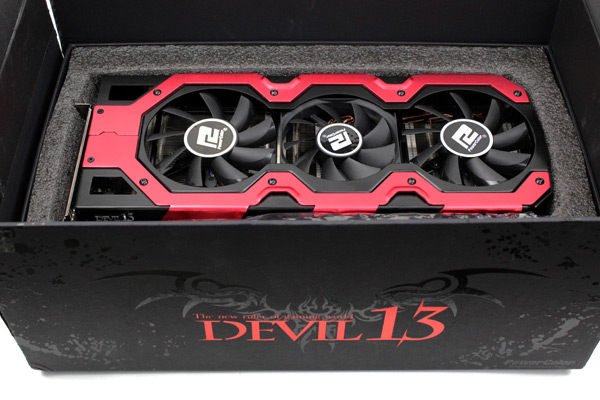
GPUZ confirmed the Devil 13 runs at 925MHz and that loading turbo BIOS ups it to 1000MHz. Unfortunately, loading the BIOS can’t be done on the fly and although the Turbo can be switched whenever you wish, the new BIOS will load only after you restart your computer. The turbo BIOS switch is placed on the I/O panel for accessibility reasons.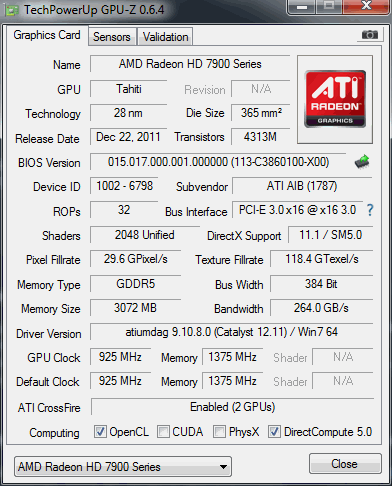
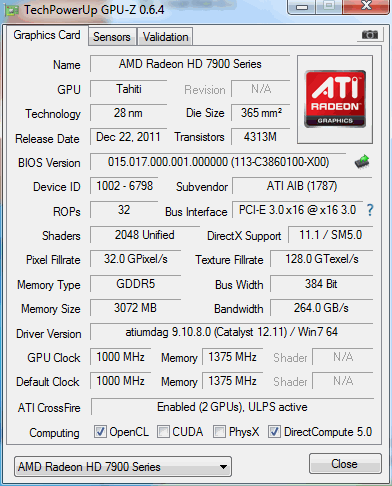
Inside the pretty large box are a few standard items you’ll need, as well as a few surprises.
You will receive:
- instruction manuals,
- driver CD,
- three 6-pin to 8-pin power cables,
- adapters: 1x mini-DP-to-DVI,
1x active mini-DP-to-DVI,
1x DVI-to-VGA,
- CrossFire Bridge,
- 11-piece Wiha Screwdriver set,
- PowerJack card supporter that’s maximum 235mm long, and will prevent warping and/or bending of the 1.77kg
heavy Devil 13 card under its weight.
The package has no pictures of the card, but does it really need to – it’s sleek and modern, while hinting at the beast inside. The Devil 13 HD 7990 comes with a three year warranty.

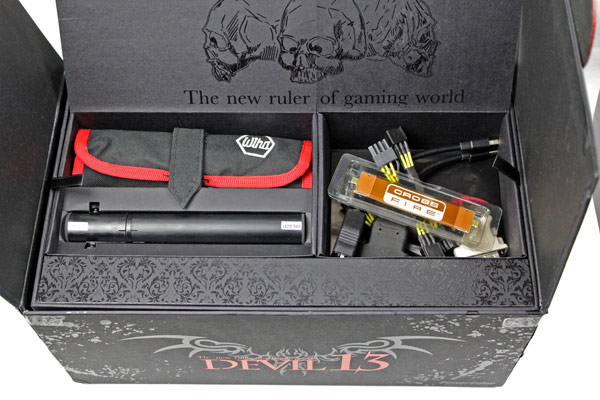

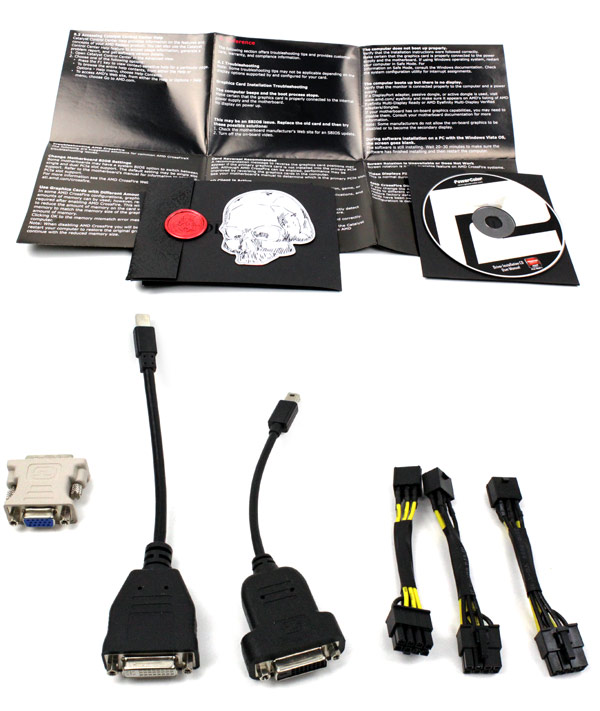
The Devil 13 HD 7990 looks powerful. It’s huge though, measuring 31.75cm (12.5 inches) in length, 13.8cm in height. It takes up three slots and weighs in at 1.77kg, believe it or not. It goes without saying that the card will have to be secured well, which is why the company bundles the PowerJack.



The fans take up one slot, while the heatsink takes up two. In between the two 85mm fans is a single 75mm one. Fan RPM can be regulated via Catalyst Overdrive. All the fans are connected via a single 4-pin connector.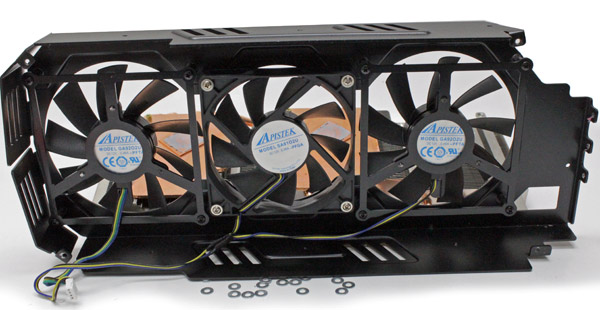
The PCB carries two Tahiti XT graphics processors. We’re talking about first generation chips that run at 925MHz, rather than the 1GHz Edition versions. The internal bridge (PEX 8747 from PLX) is in charge of communication between GPUs and comes with its own little heatsink.
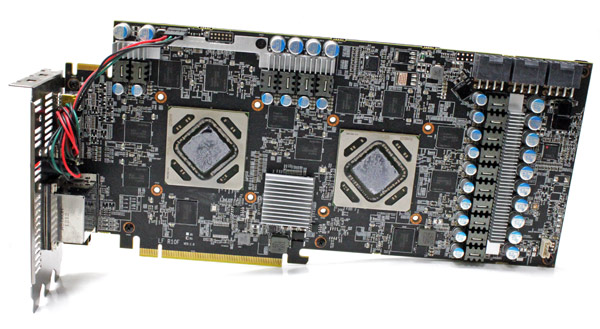
Close to the CrossFire connector is another that resembles a fan connector, but it’s actually the BIOS connector that’s routed to the turbo switch on the I/O panel. The turbo switch will overclock the GPU by 8 percent, i.e. from 925MHz to 1000MHz, and will glow once pressed. Note that the new BIOS will not load until you’ve restarted the machine.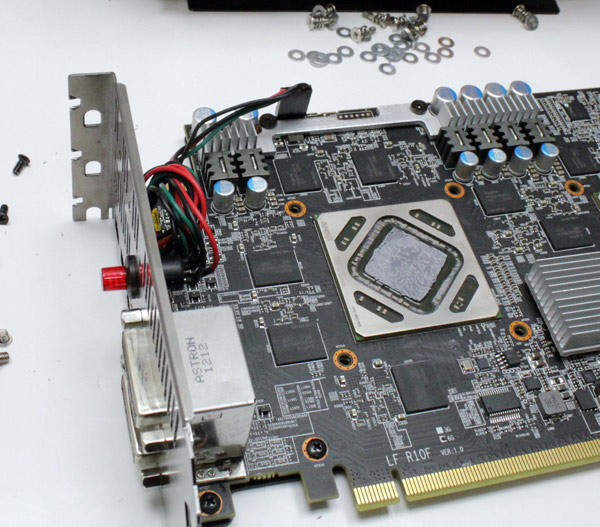
The card packs 6GB of GDDR5, so each GPU has 3GB at its disposal. The memory is Hynix’ and runs at 1375MHz. However, it’s specified to run at 1500MHz, so we expect to boost it with some overclocking.
Considering it’s a three slot cooler, we expected the heatsink to be bigger. Taking the cooler apart will require a lot of screwdriver work and patience. The screws that keep the cooler attached to the card are on the back of the card. Each of these screws has four washers for better grip.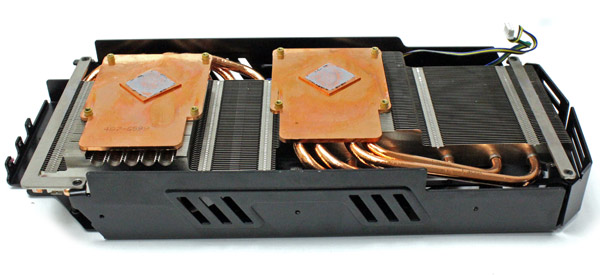


The Devil 13 HD 7990 needs three 8-pin power connectors, which, coupled with PCI-Express power, provides up to 525W. Both GPUs have 6-phase power. On the back of the card are 6 LEDs that display power status.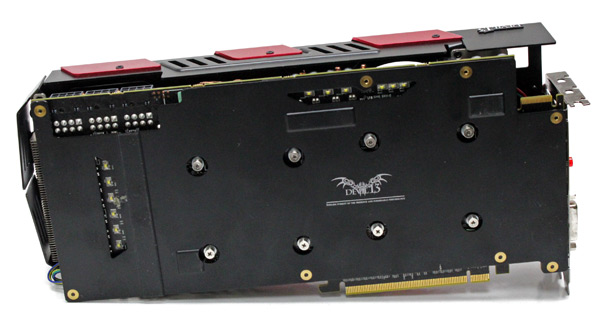
The rest of the HD 7900 series cards have similar connector layout, i.e. two DVIs, two mini-DisplayPorts and one HDMI. The Devil 13 however comes with an active mini-DisplayPort-to-DVI dongle, which means the card can drive three displays via DVIs, but also you may use all the outputs at the same time.

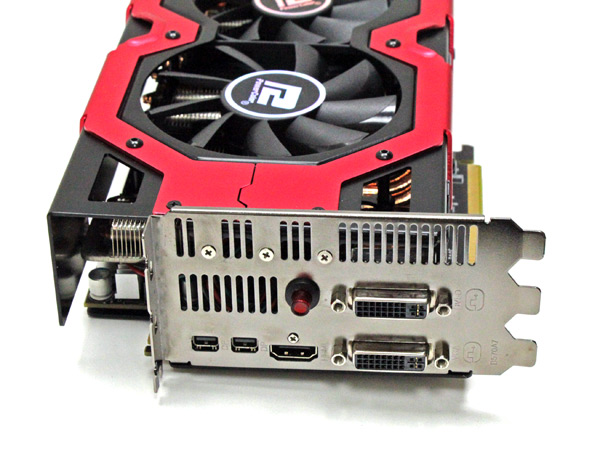
The backplate covers the back of the card and its main functions are to secure the card and make it stable, while looking good in the process. Some of the memory chips ended up on the back as well.

Testbed:
Motherboard: EVGA X79 FTW
CPU: Sandy Bridge-E Core i7 3820 (3.6GHz)
CPU Cooler: Thermalright HR-02 (Thermalright-Europa Distri www.PC-Cooling.de).
Memory: 8GB ADATA DDR3 1600 XPG Gaming series
Harddisk: OCZ Vertex 2 100 GB
Power Supply: CoolerMaster Silent Pro 1000W
Case: CoolerMaster Cosmos II Ultra Tower
Operating System: Win7 64-bit
Nvidia 306.38-desktop-win7-winvista-64bit-english-beta
AMD 12-9_vista_win7_64_dd_ccc
GTX 690 4GB driver-310.33-beta
Devil 13 HD 7990 12-11_beta4
Crysis 2 is one of those games that usually aren’t great with CrossFire. Luckily, AMD addressed this with the latest driver update and it ran well.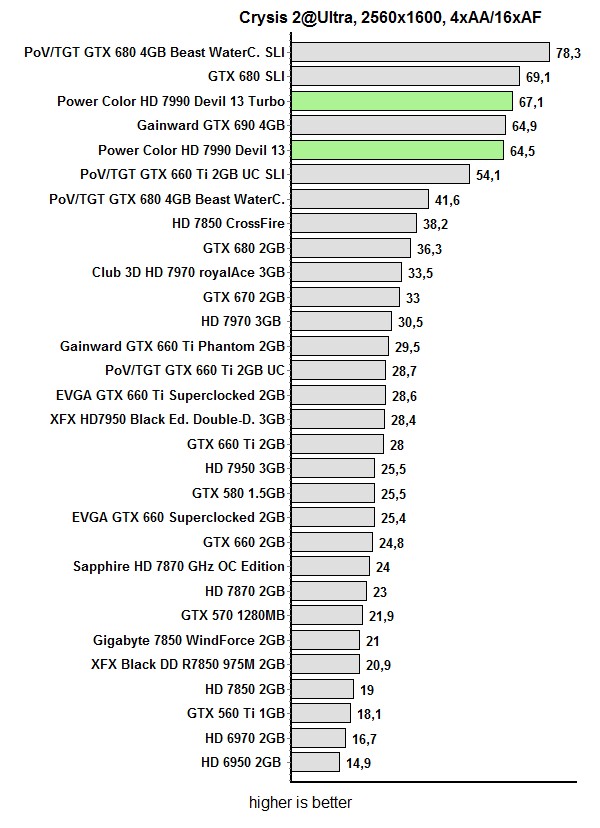
Aliens vs Predator loves them Radeons. The HD 7990 Devil 13 scored 33 percent higher than the GTX 690.
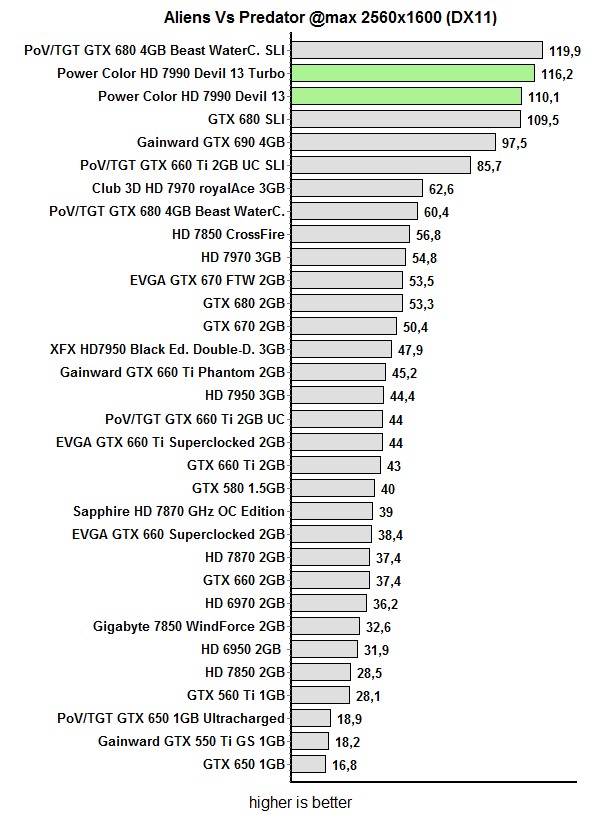
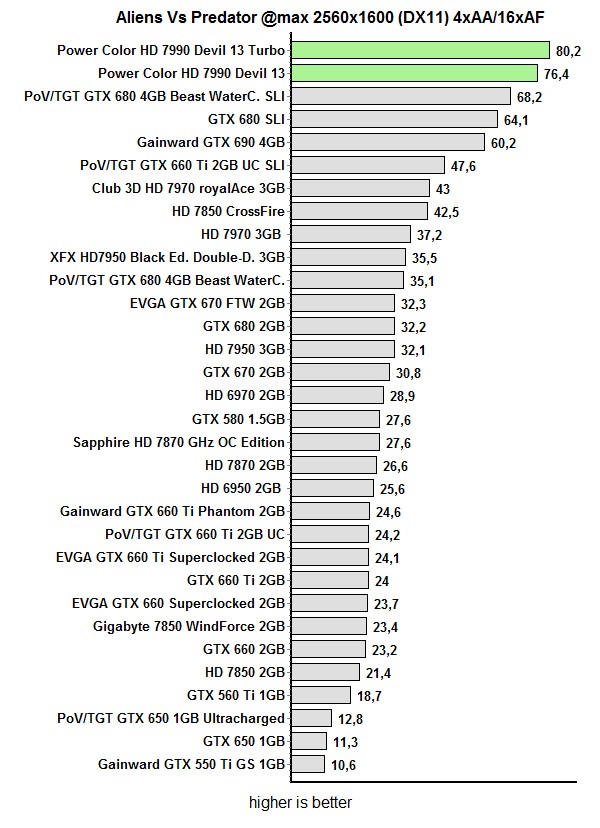
AMD has done plenty of work on drivers lately, so its cards do quite well in many games that previously favored Nvidia.
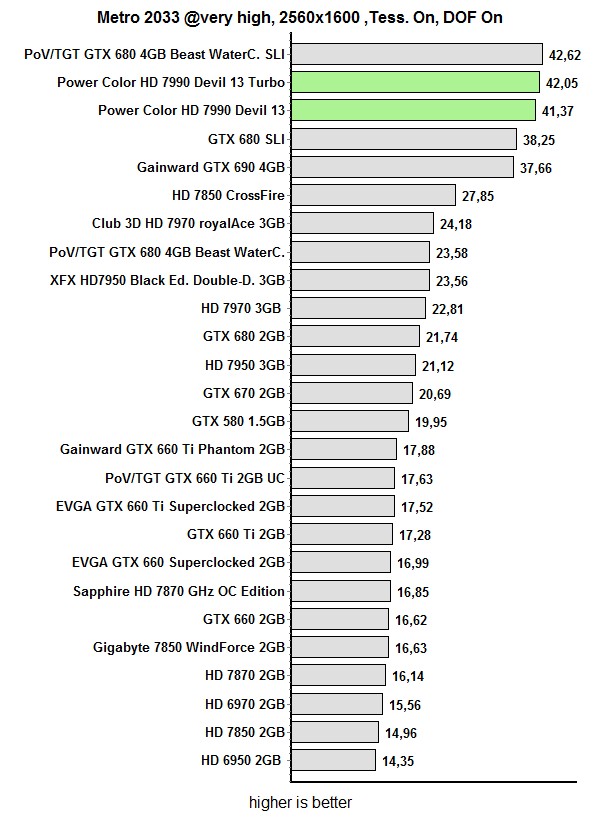
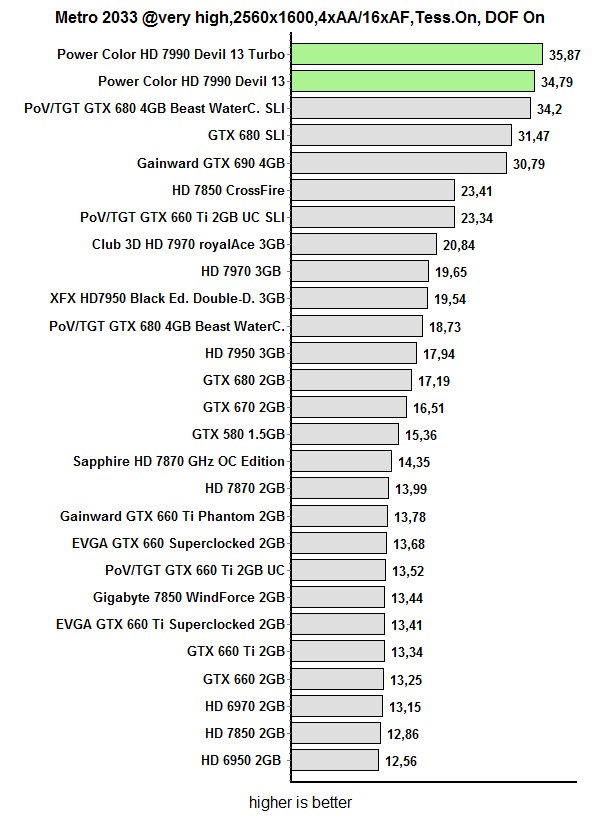
AMD’s cards aren’t slouches in tessellation either, and aren’t far behind Nvidia.
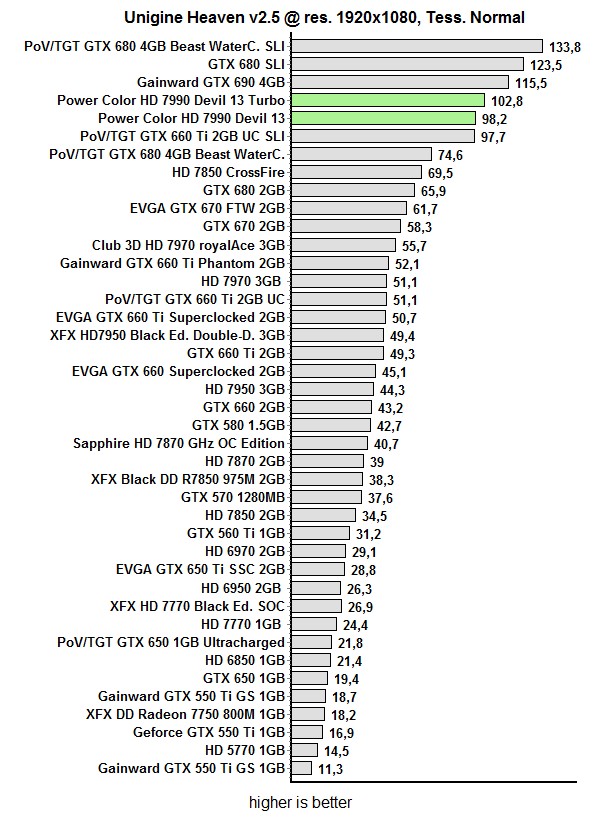
Dual GPU Devil 13 HD 7990 comes with a turbo switch that overclocks the GPU from 925MHz to 1000MHz. The switch doesn’t affect memory, which will remain at 1375MHz (5500MHz GDDR5 effectively).
Note that the memory is specified at 1500MHz and we had no trouble upping the clock from 1375MHz to this number. The GPU cooperated quite well too, and we easily overclocked it to 1125MHz without any voltage or fan RPM changes.
PowerColor has its own overclocking tool dubbed the Powerup Tuner, which offers basic options to overclock the GPU, memory or manage fan RPM.
The Devil 13 HD 7990 we received had no issues with GPU thermals, unlike the first batch of these cards that was sent out to reviewers. It’s strange how the problem went largely unnoticed at first, but thankfully it didn’t require redesigning the cooler. Namely, the GPU overheated because the cooler wasn’t tightened enough, but the company solved this by adding extra washers, so retail versions of the card have normal thermals. You can check out the washers below.
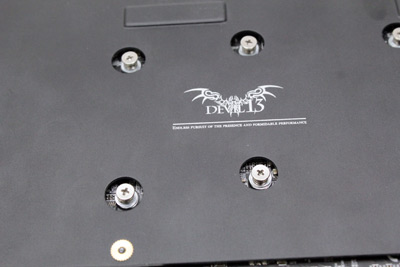
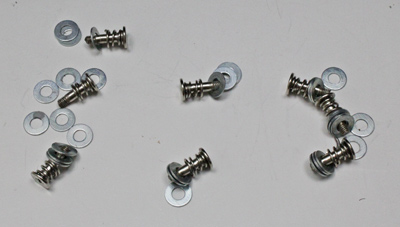
When idle, the Devil 13 isn’t fully inaudible, but you won’t hear it much either. Once the GPU is loaded, the fans will be noticeably loud, but still far from unpleasant because the noise isn’t high pitched. The GTX 690 is quieter although it has dual slot cooling with a single fan. Note that Devil 13 cooler takes up three slots and has three fans. You can manage fan RPM via most popular tools.
If there’s anything good about loud fans, it’s quality thermals. Namely, GPU temperatures didn’t exceed 76°C. After we overclocked the card to 1125MHz GPU and 1500MHz memory, the figure increased by two (78°C).
Power Color Devil 13 HD 7990 graphics card quickly took the top spot when it comes to power consumption. Nvidia’s GTX 690 ended up on average some 50W better than the Devil 13. Once the turbo BIOS switch is activated, the card will consume 10 to 15W more, but this is to be expected as it also involves an 8 percent GPU clock boost.

Power Color HD 7990 Devil 13 is the first card to combine two Tahiti XT graphics processors onto a single PCB. We must say we expected AMD to come up with the card first, but it wasn’t the case and many partners are already preparing to launch their own HD 7990 cards. In fact, HIS’ HD 7970 X2 is almost done, so Power Color’s Devil 13 will soon get a worthy opponent from its own family.
The Devil 13’s fiercest adversary though is the GTX 690, which turned out superior in quite a few fields. When it comes to performance, there are no clear cut winners, at least not as decisively as we used to see. The Devil 13 HD 7990 will wipe the floor with the GTX 690 in some games, but the GTX 690 repays the “favor” in others. Nvidia’s champ leads when it comes to silence, consumption and driver stability.
We got the impression that the GTX 690’s SLI runs better than the HD 7990’s CrossFire. However, the latest application profile solves certain CrossFire issues in some games, most notable of which in our case was Crysis 2.
The Devil 13 HD 7990 runs at 925MHz for the GPU and 1375MHz for GDDR5 memory, but switching on turbo BIOS will overclock the GPU to 1000MHz. We didn’t expect much when it comes to further overclocking potential, but overclocking the GPU to 1125MHz was a breeze.
Of course, all that muscle comes at a price and the Devil 13 HD 7990 is the hungriest card we’ve had on our test lately. Due to high power demands, the Devil 13 has three 8-pin power connectors.
The triple-slot cooler looks powerful and does a pretty good job, but we were slightly disappointed with noise levels. The fans, three of them to be exact, are noticeably louder than the GTX 690’s single fan.
The Devil 13 HD 7990 can drive five monitors (up to three DVI displays thanks to bundled active mini-DP-to-DVI dongle).
Power Color’s HD 7990 that runs at 900MHz (slower than the Devil 13) costs around €880, which is what the cheapest GTX 690 goes for. The Devil 13 HD 7990, with its turbo overclocking, is priced €50 higher.
Power Color made and launched the HD 7990 on its own and this effort should not go unrewarded. It is thanks to this company that we got to see a Radeon with two Tahiti XT graphics processors, while the GTX 690 got itself a worthy opponent.




